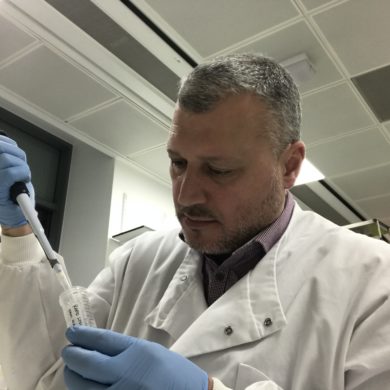Overview
This factsheet is about adhesions
Adhesions are areas of scar tissue that can cause organs or tissues in the abdomen to stick together. Usually found in the small intestine where it loops and piles up, adhesions can cause some of these loops to stick together, which can result in abdominal pain and occasionally obstruction (blockages) in the gut. Adhesions can also be found in any part of the intestines as well as other organs within the abdomen.
Causes
Causes of adhesions
Scar tissue is part of any healing process, so adhesions develop in almost all patients who undergoing surgery to the abdomen. However, problems can start to occur when this scar tissue becomes fibrotic and develops to a point where it sticks to organs or other loops of bowel. In people who haven’t had surgery adhesions can also sometimes form due to conditions such as endometriosis or following infections or inflammation within the abdomen.
Symptoms
What are the usual symptoms of adhesions?
Adhesions often cause no symptoms at all. However, they can cause kinks or twists in the gut, reducing the movement of the gut, causing obstruction and other symptoms, including recurrent episodes of colicky (cramping) abdominal pain, bloating, nausea (feeling sick), vomiting (being sick) and a change in stool frequency and consistency. Pain from adhesions is caused by the increased muscle contraction of the gut trying to force its contents through the narrowed segment. Adhesions can result in long term abdominal pain (chronic pain syndrome), which can be difficult to treat. If the bladder is affected by adhesions it can cause urinary problems whilst adhesions on or around the ovaries can lead to difficulty with conception or infertility.
How are adhesions diagnosed?
If the symptoms are typical of adhesions and there is a history of previous abdominal surgery, then the doctor may suspect adhesions and request further investigation. These may include:
- MRI scan of the small bowel: this involves drinking a liquid that highlights the shape of the bowel and may indicate presence of adhesions by highlighting abnormal dilatation (enlargement) or kinking of a region of the small bowel.
- CT scan: this may be carried out as these can sometimes show evidence of adhesions although it is important to note that they can also miss the presence of adhesions, so this is usually carried out as an addition to the MRI scan.
- Laparoscopic surgery: the only way to be sure of the presence of adhesions is for the surgeon to look inside the abdomen and see if there are adhesions and exactly where they are located. This is almost always done via laparoscopic (keyhole) surgery which means there will be a few small incisions/cuts made into the abdomen, rather than a large cut. However, it is important to be aware that any surgery will increase the risk of further adhesions forming, so surgery is not a cure.
How can Adhesions affect you?
Whilst most people with adhesions will never be troubled, others can be impacted in two main ways. The first and most common is its overall impact on general wellbeing caused by symptoms. These may include intermittent pain ranging from mild to severe, sickness and nausea.
The other way that adhesions can affect you is because of the complications from the actual condition. These include:
- Partial or complete obstruction: In cases of partial (or ‘sub-acute’) obstruction symptoms such as bloating, pain and nausea can come and go intermittently over time. A complete obstruction is where the development of adhesions can cause the bowel to become narrowed and, as a result, food and stools cannot move freely through the gut. In this case it is likely the patient will be admitted to hospital. In very severe cases, the bowel becomes completely blocked and the patients may not be able to pass stools or wind and will be in constant severe pain with vomiting, which sometimes contains gut content such as faeces.
- Strangulation: very rarely, adhesions can cause the gut to twist, cutting off its blood supply (‘strangulation’) and this can cause sudden, severe abdominal pain and bleeding from the back passage. This is an emergency and medical attention must be sought immediately.
- Chronic pain: This is rare, but it can cause major upset, frustration and feelings of hopelessness among many patients. If you are experiencing any of these feeling it is important to let your doctor know so that they can make an appropriate referral for emotional support.
Do adhesions need to be monitored and if so, how?
Once adhesions have been diagnosed, consultation with a surgeon will help to decide whether surgical intervention is required. If surgery is not recommended, then medications and changes in diet may be needed. Therefore, a follow-up appointment with your doctor is crucial to ensure that your symptoms are being well controlled. If pain is not well controlled, referral can be made to a pain specialist.
Treatment
How are adhesions treated?
The majority of patients with adhesions do not need treatment. However dependent on symptoms, treatments include:
- If pain is a symptom, then over the counter pain relief such as paracetamol or ibuprofen is usually recommended initially but if these do not help then the patient should see a doctor who can recommend other treatments and consider referral to a pain specialist.
- If a blockage is suspected, hospital admission may be required for observation. Often ‘bowel rest’ is advised, which means no eating or drinking for 24-48 hours while fluids are given into the vein to help with hydration and salt replacement. Sips of water are slowly introduced, followed by soft and then more solid foods. If the blockage does not improve, surgery may be recommended.
- A change in diet. Introducing foods low in fibre or soft foods so that stools can pass through the gut more easily, ensuring a good fluid intake is also important.
- If the adhesions are causing issues with conception, then the patient should be referred to a gynaecologist.
- Complete obstruction or twisted bowel. Pain that does not respond to non-surgical treatment. In these cases, surgery will usually be the next line of treatment. Known as ‘adhesiolysis’ this involves cutting through the adhesions so that organs or intestine loops are no longer sticking together. Surgery is almost always carried out laparoscopically (keyhole surgery) however, very rarely and usually only in an emergency, open surgery may be used. Unfortunately, new adhesions can form after any surgery and although good surgical technique can help to reduce the likelihood of this, they cannot entirely avoid it. After surgery, symptoms may improve, stay the same or get worse although some patients require numerous surgeries resulting in long term symptoms.
Support
What to ask your doctor
- May I be referred to a dietitian to see if there are any changes to my diet that may help with my symptoms?
- What are the risks and benefits of surgery for me?
- Are there any other treatments I can try before going ahead with surgery?
- Are there any treatments that I need to avoid because of adhesions?
 ABOUT US:
ABOUT US:
Guts UK is the only UK charity funding research into the digestive system from top to tail; the gut, liver and pancreas.
Our guts have been underfunded, understaffed and undervalued for decades. Together, we will join forces and bring about important change in this misunderstood area of health.
With new knowledge, we will end the pain and suffering for the millions affected by digestive diseases. Guts UK’s research leads to earlier diagnoses, kinder treatments and ultimately, a cure.
Help the UK get to grips with guts by donating today.



